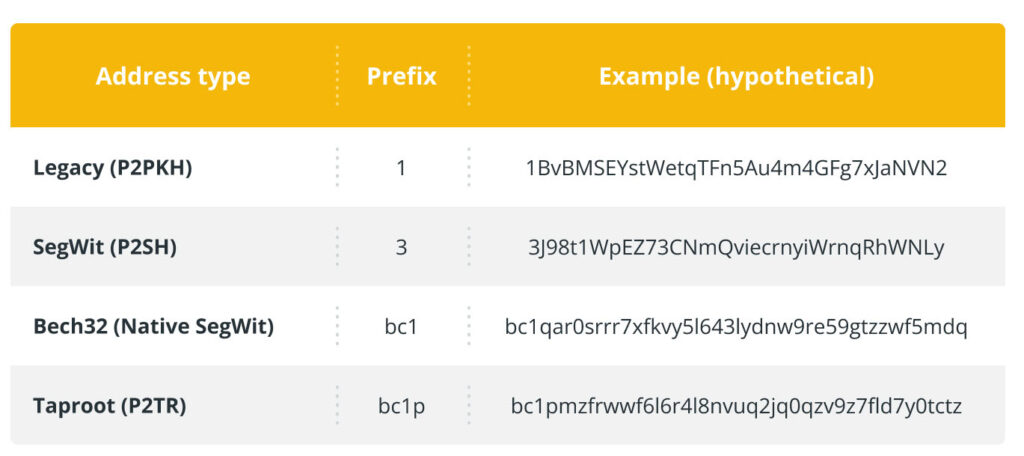Bitcoin wallet address types consist of alphanumeric characters and are essential for conducting transactions. Understanding their components is essential for secure and accurate transfers.
This article explains the different types of address formats for Bitcoin and how to correctly interpret Bitcoin addresses.
What is a Bitcoin address?
A Bitcoin address is an alphabetical string that is specific to the destination of a Bitcoin transaction. These addresses usually start with "1", "3", or "bc1" and are case-sensitive.
They act as a unique identifier for the recipient and allow for the secure sending and receiving of Bitcoin.
Public and private key pairs are the basis of a Bitcoin address.
The public key is converted to a shorter, more manageable version for sharing purposes.
The recipient address is used to prove ownership of the funds received, and transactions are recorded on the blockchain.
These addresses are essential for validating and verifying transactions within the Bitcoin network,
But they give users a certain amount of anonymity because they hide personal information like names and locations.
How are Bitcoin addresses created?
Bitcoin wallet address types are derived from public keys through encryption and hashing.
Public keys – which are derived from private keys – are essential because they enable the creation of digital signatures in Bitcoin transactions.
These signatures enable transactions on the blockchain and verify who owns the funds.
A critical component of Bitcoin's operation, hash functions are used to construct shorter, fixed-length representations of data, including public keys.
These hash algorithms ensure that Bitcoin addresses are compact and standardized,
Which makes data storage and transmission on the blockchain network more efficient.
Different Bitcoin address formats
Due to the evolution of Bitcoin technology and the need to accommodate different functions while maintaining stability and compatibility with previous functions, there are several Bitcoin address formats.
Types of Bitcoin wallet addresses are Bitcoin testnet addresses that start with "2" and are usually
The Testnet address format uses Pay-to-Witness-Public-Key-Hash (P2WPKH) in Segregated Witness (SegWit).
These addresses are used for testing and experimentation on the Bitcoin testnet, allowing developers to explore new features and applications without risking real Bitcoin.
Often, Bitcoin address displays display these addresses as QR codes to make them easier to scan and transact using mobile devices.
Users can interact using different Bitcoin address formats, as explained below:
Types of Bitcoin Wallet Addresses – Legacy (P2PKH)
This is the widely used original format, encoded using Base58, which removes characters that are often confused with each other.
Addresses starting with "1" use the Pay-to-Public-Key-Hash (P2PKH) script type and are case-sensitive.
In the context of P2PKH, "pay to" refers to the recipient's ability to claim funds, "public key" refers to the recipient's public cryptographic key, and "hash" refers to the cryptographic hash of the public key.
These types of addresses provide a simple way to send and receive Bitcoin, as they are generated from a hash of the recipient's public key.
Legacy addresses are widely compatible with all platforms as most wallets and exchanges support them.
Recommended article: The difference between private, public keys and wallet addresses
Types of Bitcoin Wallet Addresses – SegWit (P2SH)
The scalability problems of the Bitcoin network were partially resolved with the introduction of SegWit.
Addresses that start with “3” use Base58 encoding,
They are based on the Pay-to-Script-Hash (P2SH) script type and are case-sensitive like old addresses.
By separating signature data from transaction data, SegWit addresses offer many benefits, including higher throughput and lower costs.
This format increases the overall efficiency of the Bitcoin network and allows for the integration of advanced features such as the Lightning Network.

Bitcoin Wallet Address Types – Bech32 (Native SegWit)
Addresses starting with “bc1” or Bech32 addresses are based on the native SegWit protocol.
They offer the lowest transaction fees and the most efficient use of block space.
Compared to previous forms, Bech32 addresses use only lowercase letters, improve error detection, and are more human-readable.
They are best suited for new services and applications that seek to leverage the full capabilities of the Bitcoin network and encourage adoption of SegWit technology.
Taproot Address (P2TR)
Taproot (P2TR) addresses, also known as Taproot or Bech32m, are the newest and most advanced Bitcoin address format.
These addresses are case sensitive and start with bc1p.
They improve scalability, flexibility, privacy, and security, but like SegWit, they are selective and not yet commonly supported.
Taproot offers benefits such as Schnorr signatures, which reduce costs, increase security, and also allow for the creation of smart contracts.
Recommended video: How to create a Bitcoin wallet with a custom prefix
Change address in Bitcoin
In a Bitcoin transaction, a change address is a type of Bitcoin wallet address that is an additional output address that receives remaining funds from inputs.
When a transaction is created and the total value of the inputs is greater than the amount transferred, the system returns the excess amount, called change, to one of the sender's addresses.
This ensures that the entire value of the inputs is accounted for and not lost.
Changing the address obscures which output is a change and which is a payment, helping to maintain security and anonymity.
Imagine that John has 1 Bitcoin in his wallet and wants to send 0.5 Bitcoin to Alice.
John initiates a deal so that Alice can receive the agreed amount.
John adds a change address from his wallet to receive the final 0.5 Bitcoin in addition to Alice address as the beneficiary.
With this modification, John calculates the total value of his initial unspent transaction output (UTXO) so that it is not lost.
UTXO represents received but not yet spent Bitcoin and acts as an input for new transactions, ensuring ownership and preventing double spending.
After confirming the transaction, Alice receives 0.5 Bitcoin, and John's wallet now has two UTXOs – one for the amount delivered to Alice and one for change.
By doing this, John maintains control of his funds and ensures that no Bitcoin is lost during the transaction.
Watch video tutorials on Bitdemy YouTube



















